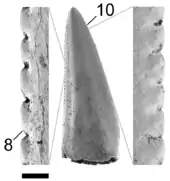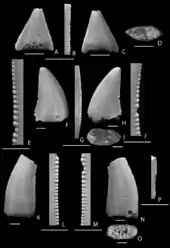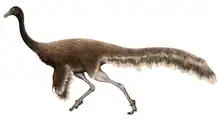| Richardoestesia Temporal range: Late Cretaceous, Possible Early Cretaceous (Barremian) records from teeth of the Cedar Mountain Formation, but see [1]. | |
|---|---|
 | |
| Tooth of cf. R. gilmorei with close up of denticles | |
| Scientific classification | |
| Domain: | Eukaryota |
| Kingdom: | Animalia |
| Phylum: | Chordata |
| Clade: | Dinosauria |
| Clade: | Saurischia |
| Clade: | Theropoda |
| Clade: | Coelurosauria |
| Genus: | †Richardoestesia Currie, Rigby & Sloan, 1990 |
| Type species | |
| †Richardoestesia gilmorei Currie, Rigby & Sloan, 1990 | |
| Other species | |
| |
| Synonyms | |
| |
Richardoestesia is a morphogenus of theropod dinosaur teeth, originally described from the Late Cretaceous of what is now Canada, the United States and Kazakhstan. It currently contains two species, R. gilmorei and R. isosceles, and a possible third, R. asiatica. It has been used as a morphotaxon to describe other theropod teeth widely displaced in time and space from the type species. If all teeth assigned to the genus are truly reflective of the animals biology and taxonomic state, it would have been one of the longest lasting dinosaur genera, perhaps also being the most widely distributed.
History

The jaws were found in 1917 by Charles Hazelius Sternberg and sons in the Dinosaur Provincial Park in Alberta at the Little Sandhill Creek site. In 1924 Charles Whitney Gilmore named Chirostenotes pergracilis and referred the jaws to this species.[2] In the 1980s it became clear that Chirostenotes was an oviraptorosaur to which the long jaws could not have belonged. Therefore, in 1990 Phillip Currie, John Keith Rigby and Robert Evan Sloan named a separate species: Richardoestesia gilmorei.[3]
The genus is named for Richard Estes, to honor his important work[4] on small vertebrates and especially theropod teeth of the Late Cretaceous. The naming authors actually intended to use the spelling Ricardoestesia, Ricardus being the normal latinisation of "Richard". However, except in one overlooked figure caption, the editors of the paper altered the spelling to include the 'h'.[5] Ironically, in 1991 George Olshevsky in a species list also used the spelling Richardoestesia, and indicated Ricardoestesia to be the misspelling, unaware that the original authors actually intended the name to be spelled this way. As a result, under ICZN rules, he acted as "first revisor" choosing between the two spelling variants of the original publication and inadvertently made the misspelt name official. Subsequently, the original authors have adopted the spelling Richardoestesia. The specific name honors Gilmore.
Species
The holotype specimen of Richardoestesia gilmorei (NMC 343) consists of a pair of lower jaws found in the upper Judith River Group, dating from the Campanian age, about 75 million years ago. The jaws are slender and rather long, 193 millimeters, but the teeth are small and very finely serrated with five to six denticles per millimeter. The serration density is a distinctive trait of the species.
In 2001, Julia Sankey named a second species: Richardoestesia isosceles, based on a tooth, LSUMGS 489:6238, from the Texan Aguja Formation, which is of a longer and less recurved type.[6] The teeth of R. isosceles have also been identified as crocodyliform in shape, possibly belonging to a sebecosuchian.[7]
In 2013 a study assumed that the teeth of the coelurosaur Asiamericana asiatica, from the CBI-14 site of the Bissekty Formation in Kazakhstan,[8] were identical to those of Richardoestesia isosceles, and renamed the species into Richardoestesia asiatica.[9] A subsequent study confirmed this in 2019.[10] The holotype of R. asiatica is CCMGE 460/12457,[11] and two other teeth (ZIN PH 1110/ 16 and ZIN PH 1129/16) are also known.[10]
Classification

Richardoestesia-like teeth have been found in many Late Cretaceous geological formations, including the Horseshoe Canyon Formation, the Scollard Formation, Hell Creek Formation, Ferris Formation, and the Lance Formation (dated to about 66 million years ago). Similar teeth have been referred to this genus from as early as the Barremian age (Cedar Mountain Formation, 125 million years ago).[1]
Because of the disparity in location and time of the many referred teeth, researchers have cast doubt on the idea that they all belong to the same genus or species, and the genus is best considered a form taxon. A comparative study of the teeth published in 2013 demonstrated that both R. gilmorei and R. isosceles were only definitively present in the Dinosaur Park Formation, dated to between 76.5 and 75 million years ago. R. isosceles was also present in the Aguja Formation, roughly the same age. All other referred teeth most likely belong to different species, which have not been named due to the lack of body fossils for comparison.[12]
Fossils of Richardoestesia have also been found in the Tremp Formation of northeastern Spain (Blasi 2 member).[13]
Paleobiology

At least a few studies have speculated a piscivorous lifestyle for Richardoestesia, due to its vast distribution as well as predominance in marine sites.[14][15]
References
- 1 2 Kirkland, Lucas and Estep, (1998). "Cretaceous dinosaurs of the Colorado Plateau." in Lucas, Kirkland and Estep (eds.). Lower and Middle Cretaceous Terrestrial Ecosystems. New Mexico Museum of Natural History and Science Bulletin, 14, 79-89.
- ↑ Gilmore, C.W., 1924, "A new coelurid dinosaur from the Belly River Cretaceous of Alberta", Canada Department of Mines Geological Survey Bulletin (Geological Series) 38(43): 1-12
- ↑ Currie, P. J., K. J. Rigby, and R. E. Sloan. 1990. "Theropod teeth from the Judith River Formation of southern Alberta, Canada". Pp. 107–125. In P. J. Currie, and K. Carpenter, eds. Dinosaur Systematics: Perspectives and Approaches. Cambridge University Press, Cambridge.
- ↑ Estes, R., 1964, Fossil vertebrates from the Late Cretaceous Lance Formation, eastern Wyoming. University of California Publications in Geological Sciences 49: 1-180
- ↑ Archived 2016-08-06 at the Wayback Machine
- ↑ J.T. Sankey, 2001, "Late Campanian southern dinosaurs, Aguja Formation, Big Bend, Texas", Journal of Paleontology 75(1): 208-215
- ↑ Company, J.; Suberbiola, X.P.; Ruiz-Omenaca, J.I.; Buscalioni, A.D. (2005). "A new species of Doratodon (Crocodyliformes: Ziphosuchia) from the Late Cretaceous of Spain" (PDF). Journal of Vertebrate Paleontology. 25 (2): 343–353. doi:10.1671/0272-4634(2005)025[0343:ANSODC]2.0.CO;2.
- ↑ Nessov, L. A. (1995). Dinozavri severnoi Yevrasii: Novye dannye o sostave kompleksov, ekologii i paleobiogeografii [Dinosaurs of Northern Eurasia: new data about assemblages, ecology and paleobiogeography], Scientific Research Institute of the Earth's Crust, St. Petersburg State University, St. Petersburg, Russia: 156 pp. + 14 pl. [in Russian with short English, German, and French abstracts].
- ↑ Sues H.D. and Averianov, A. (2013). "Enigmatic teeth of small theropod dinosaurs from the Upper Cretaceous (Cenomanian–Turonian) of Uzbekistan". Canadian Journal of Earth Sciences. 50: 306-314
- 1 2 Alexander Averianov & Hans-Dieter Sues. (2019). "Morphometric analysis of the teeth and taxonomy of the enigmatic theropod Richardoestesia from the Upper Cretaceous of Uzbekistan". Journal of Vertebrate Paleontology: e1614941
- ↑ Nessov, L. A. (1995). Dinozavri severnoi Yevrasii: Novye dannye o sostave kompleksov, ekologii i paleobiogeografii [Dinosaurs of Northern Eurasia: new data about assemblages, ecology and paleobiogeography], Scientific Research Institute of the Earth's Crust, St. Petersburg State University, St. Petersburg, Russia: 156 pp. + 14 pl. [in Russian with short English, German, and French abstracts].
- ↑ Larson DW, Currie PJ (2013) Multivariate Analyses of Small Theropod Dinosaur Teeth and Implications for Paleoecological Turnover through Time. PLoS ONE 8(1): e54329. doi:10.1371/journal.pone.0054329
- ↑ Blasi 2 at Fossilworks.org
- ↑ Gerardo Carbot-Chanona, Héctor E. Rivera-Sylva, Presence of a maniraptoriform dinosaur in the Late Cretaceous (Maastrichtian) of Chiapas, Southern Mexico, December 2011Boletin de la Sociedad Geologica Mexicana 63(3):393-398 Follow journal DOI: 10.18268/BSGM2011v63n3a2
- ↑ Longrich, N., 2008, Small theropod teeth from the Lance Formation of Wyoming, USA, in Sankey, J.T., Baszio, S. (eds.), Vertebrate microfossil assemblages: their role in paleoecology and paleobiogeography: Bloomington, Indiana, Indiana University Press, 135-158. (5) (PDF) Presence of a maniraptoriform dinosaur in the Late Cretaceous (Maastrichtian) of Chiapas, Southern Mexico. Available from www.researchgate.net [accessed March 14, 2021].
Further reading
- Baszio, S. 1997. Investigations on Canadian dinosaurs: systematic palaeontology of isolated dinosaur teeth from the Latest Cretaceous of Dinosaur Provincial Park, Alberta, Canada. Courier Forschungsinstitut Senckenberg 196:33-77.
- Sankey, J. T., D. B. Brinkman, M. Guenther, and P. J. Currie. 2002. Small theropod and bird teeth from the Late Cretaceous (Late Campanian) Judith River Group, Alberta. Journal of Paleontology 76(4):751-763.
External links
 Media related to Richardoestesia at Wikimedia Commons
Media related to Richardoestesia at Wikimedia Commons- The "Ricardoestesia typo" is described Archived 2016-08-06 at the Wayback Machine
- First message of a passionate Ricardoestesia versus Richardoestesia debate Archived 2020-08-06 at the Wayback Machine

.jpg.webp)












